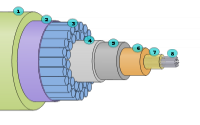Underseas cables are vital to global economy
Undersea cables are a valuable commodity in the 21st century global communication environment. The undersea consortium is owned by various international companies such as ATT, and these companies provide high-speed broadband connectivity and capacity for large geographic areas that are important entities of trade and communications around the globe. If undersea cables were cut or disrupted outside of the U.S. territorial waters, even for a few hours, the capability of modern U.S warfare that encompasses battle space communications and awareness, protection, and the stability of the financial networks would be at risk.
Quicktabs: Arguments
Many people around the world believe that their emails and phone messages are being sent through satellites. They are mistaken because satellites account for less than 5%.1 Global telecommunications development began about 150 years ago with the first commercial international submarine cable, laid between Dover, England and Calais, France in 1850. In 1858, the first trans-Atlantic telegraph cable linked London with the new world, via Newfoundland.2 The 143 words transmitted in 10 hours, replaced a one-way dispatch that would have previously taken about 12 days.3
In the last 25 years, there has been a stunning growth in undersea cables because of the communications revolution triggered by the internet. Undersea cables account for 95% of the world’s international voice and data traffic (Military, Government, Emergency Response, Air Traffic Control, Subway, Rail, and Port Traffic).4 Financial markets utilize undersea cables to transfer trillions of dollars every day. In 2004 alone, nine million messages and approximately $7.4 trillion a day was traded on cables transmitting data between 208 countries.5 As a result, submarine (undersea) cables are vital infrastructure to the global economy and the world's communication system.
Douglas Burnett, a legal expert on undersea cables notes that international banking institutions process over $ 1 trillion dollars per day via undersea cables. Any disruptions of these cables would severely impact global banking. Indeed, Stephen Malphrus, Chief of Staff to Federal Reserve Chairman Ben Bernanke, recently noted, “When communication networks go down, the financial services sector does not grind to a halt, rather it snaps to a halt.6 Even though there are hundreds of cables crossing the global seabed, there are just not enough undersea communication network redundancies available to handle the vast amount of bandwidth needed to keep global banking transactions in check.
Destruction of submarine cables can cripple the world economy to include the global financial market and/or Department of Defense (DoD). An example which reflects the importance of this strategic communication capability took place on December 26, 2006, when a powerful earthquake off Southern Taiwan cut 9 cables and took 11 repair ships 49 days to restore. The earthquake affected Internet links, financial markets, banking, airline bookings and general communications in China, Hong Kong, India, Singapore, Taiwan, Japan and the Philippines.7 When a cable loses service, it has a definite, but difficult impact to the global financial sector. The International Cable Protection Committee (ICPC) legal advisor estimates that interruptions of underwater fiber optics communications systems have a financial impact excess of $1.5 million per hour.8 These estimates target operators that utilize cable bandwidth for day-to-day operations and companies or government entities that own bandwidth on the disrupted cable.9
Undersea cables are a valuable commodity in the 21st century global communication environment. The undersea consortium is owned by various international companies such as ATT, and these companies provide high-speed broadband connectivity and capacity for large geographic areas that are important entities of trade and communications around the globe.41 For example, the U.S. Clearing House Interbank Payment System processes in excess of $1 trillion a day for investment companies, securities and commodities exchange organizations, banks, and other financial institutions from more than 22 countries.42 The majority of their transactions are transmitted via undersea cables. In addition, the Department of Defense’s (DoD’s) net-centric warfare and Global Information Grid rely on the same undersea cables that service the information and economic spheres.43 If undersea cables were cut or disrupted outside of the U.S. territorial waters, even for a few hours, the capability of modern U.S warfare that encompasses battle space communications and awareness, protection, and the stability of the financial networks would be at risk. As one analyst has noted, “the increase demand is being driven primarily from data traffic that is becoming an integral part of the everyday telecommunications infrastructure and has no boundaries.44
Submarine cables represent critical communications infrastructure, as they form the backbone of the Internet and global e-commerce. Such cables, typically consisting of optical fibers laid along the ocean floor in a bundle no larger than a garden hose, carry over 95 percent of transoceanic voice and data communication. U.S. telecom companies have worked rapidly to meet exploding consumer appetite for data, increasing the total circuit capacity of transoceanic cables landing in the U.S. by more than 1,000 fold since 1995.
There is no substitute for these underwater cables in case of damage. The earth’s satellites can carry no more than seven percent of U.S. international voice and data traffic. But worldwide, nearly 100 cable outages occur each year. The vast majority of cable outages are caused by bottom trawling fishing, dredging, and ship anchoring. Occasionally, cables are taken in an act of piracy, as occurred in 2007 when individuals in commercial vessels from Vietnam stole over 100 miles of cables on the high seas. Cable outages may disrupt governments, financial markets, and business operations and require costly repairs.
Ambiguity, coupled with our extreme reliance on undersea infrastructure, was on display in late January and early February 2008. Four undersea telecommunication cables were mysteriously cut within the course of two days, crippling Internet access across wide swaths of the Middle East and India.59 Two cable breaks were in the Mediterranean--one near Alexandria, Egypt, and the other in the waters off Marseille, France.60 The third break was thirty-five miles off the coast of Dubai and the fourth was along a cable linking the United Arab Emirates to Qatar.61 Most telecommunication experts and operators deemed sabotage unlikely, believing instead that ship anchors had severed the cables when heavy storms swept through the region.62 Nevertheless, the Egyptian Ministry of Communications refuted the presence of any ships near the Mediterranean cable cuts.63 Moreover, the improbable incidence of four cuts in 48 hours fueled speculation about military involvement.64 Sabotage theorists seized on reports of stifled Internet traffic through Iran,65 while traffic to Israel, Lebanon and Iraq was apparently immune from chaos.66 At the very least, this episode highlights how relatively small damage to undersea cables can instantly affect millions of people, and how a stealthy underwater attack- ambiguous and non-attributive in nature-could deal such a crippling blow.
Submarine cables and pipelines are vulnerable assets in the global commons.182 Their protection from undersea attack is a real prescriptive and enforcement challenge because of our extreme reliance on this critical infrastructure; its multi-jurisdictional span beyond territorial seas; the availability of precise locational coordinates; the opaque environment below the waterline; and the accessibility to commercial-grade vehicles that can exploit this environment and inflict disproportionate harm.
The opaque environment and the accessibility to UUVs set this challenge apart from challenges above the water's surface to flagged vessels and platforms. As with cyber threats, this necessitates an effective deterrence policy to compensate for an inability to pinpoint suspected culprits. Not only do legal shortcomings in jurisdiction and security enforcement float above the surface, but arguably more sinister shortcomings lurk below. These threats also require an even more delicate balance between disclosure and secrecy, and between freedom ofnavigation and reasonable restraints for collective security.
In the end, whatever vigor is applied towards cyber security, and whatever balance is struck for internet freedoms should be matched by securing the very cables that transport this life-blood of commerce. Likewise, investment in energy independence should correspond to the security of the very arteries that enable and spur offshore energy exploration.
Canals, tunnels, and bridges over straits, submarine pipelines for oil and gas,28 as well as cables serve communication and transport purposes in the widest sense. These types of marine infrastructure can easily suffer from natural disasters or become targets of terrorism.29 It may be recalled that millions of telephone, telex, TV, and data links are made across the world at every moment. They may travel on radio waves or via satellites, but the majority are transmitted by submarine cables,30 which form a network over the world's seabeds. Cables are special because they provide the privacy and security that radio and satellite lack. They are reliable and long lasting and have an excellent capacity and transmission quality. Cables are vitally important to the global economy, to national security, and to the safety of life.31 The modern version of these arteries of data flow is fiber-optic cables running through oceans, straits, and across land bridges. For example, the bulk of data flow between Europe and the Far East goes by fiber-optic cables that run from the Mediterranean through Egyptian territory into the Red Sea and the Gulf of Aden. A high concentration of cables can be found in the South China Sea, Red Sea, and Mediterranean Sea. Likewise, a growing number of subsea cables for the transport of electricity are or under construction or in the planning process. Building up redundencies or back-up solutions will add to the picture, create additional intrusion on the environment, and offer a target for terrorists. Thus, the protection of “critical” marine infrastructure is part of the agenda.
Over 70% of our country's international telecom traffic, which includes voice, data, and video, is carried on these cables, each of which is only about the diameter of a garden hose. Not counting Canada and Mexico, over 90% of the country's international voice, video, Internet, and data communications are carried on these cables. The disproportionate importance of these cables to the nation's communication infrastructure can be seen by the fact that if all of these cables were suddenly cut, only 7% of the United States traffic could be restored using every single satellite in the sky. Modern fiber optic cables are the lifeblood of the world's economy, carrying almost 100% of global Internet communication. This underscores the revolutionary5 capacity of modern fiber optic submarine cables. By any standard, they constitute critical infrastructure to the United States, and indeed the world.
Fiber-optic submarine cables are the lifeblood of U.S. carriers’ global business. Aside from our land-based connections with Canada and Mexico, more than 95 percent of U.S. international traffic – voice, video, Internet and data – travels over 38 submarine cables, each the diameter of a garden hose. Without these cables, current satellite capacity could carry only 7 percent of the total U.S. international traffic.
Fiber-optic submarine cables are the international digital trade routes of the 21st century. And thus, any disruptions to the submarine cable global network can have significant impact on the flow of digital information around the world, with severe consequences for the world economy. As one official from the Federal Reserve noted in referring to submarine cable networks, “When the communication networks go down, the financial sector does not grind to a halt, it snaps to a halt.”i
Pages

An underseas cable accident plunged the country of Yemen into a days-long internet outage, underscoring the fragility of the current internet infrastructure.
[ More ]
The U.S. and its NATO allies have warned that an uptick in Russian submarine activity near undersea fiber optic cables means Moscow may be plotting to disrupt or intercept sensitive or other critical internet communications in the event of a confrontation with the West.
[ More ]